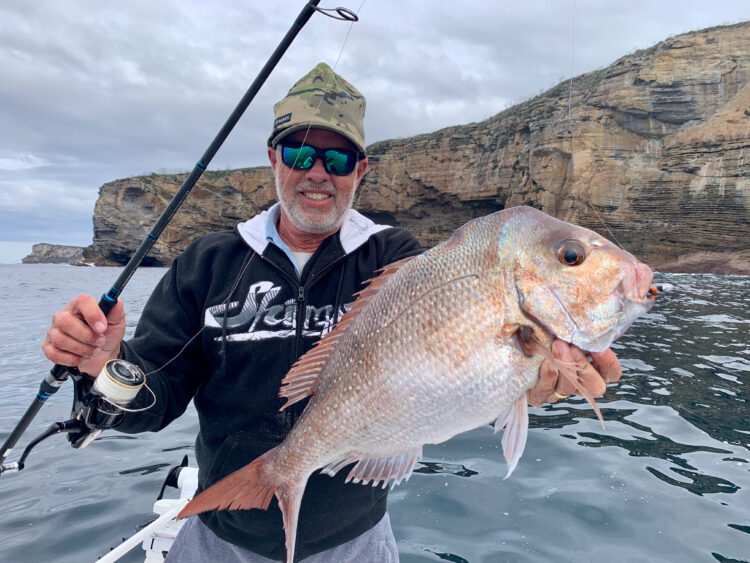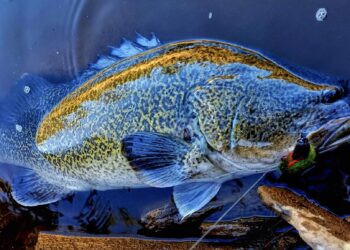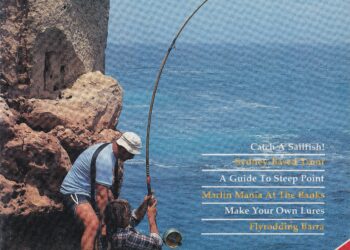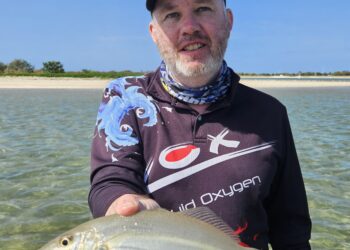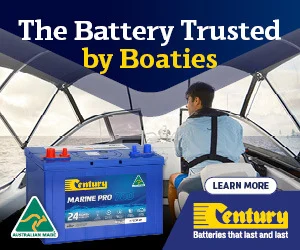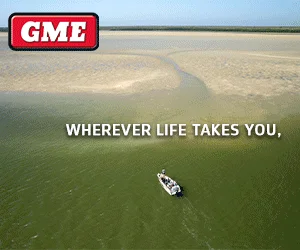I’VE had a love/hate relationship with winter over many years now. There are many things I hate when the weather cools down. Having to put a heap of clothes on, losing daylight savings, cold mornings and having to split firewood are just a few but the worst is the fact that much of my summer fishing shuts down. My beloved flats fishing is out when it gets cold. The local estuaries certainly slow down but are still fishable for a flathead or jewie.
The blackfish from the local rocks start to slow as they move into the estuaries to breed. I used to find winter quite depressing years ago but that was before I discovered our local inshore snapper
fishing during the cooler months. That realisation came slowly. It wasn’t just an overnight thing where I caught a couple of snapper in June and all of a sudden started getting regular catches.
It was about 20 years ago when we started fishing a local rock platform with bottom baits in winter. We caught some good snapper back then on overhead gear using four ounce snapper leads and octopus legs and salted bonito for bait. Thinking back I can remember catching a few
good snapper from the rocks at Gerringong as a teenager and in most of the old black and white photos I was wearing jumpers and beanies.

That land based reddie fishing was one of my grandfather’s great passions and it still exists today if you take the time to lob out bottom baits or fish floaters in the washes. These days the NSW south coast winter fishery is well documented and many in the know sportfishers enjoy it and look forward to winter. I’m a big fan and the past few seasons have produced some exceptional fishing for us.
Not a lot is known about the migration habits of snapper but what we do know is they are highly migratory and will travel long distances to breed, feed and to find favourable conditions. They are found in bays, inshore waters, estuaries and offshore right along the NSW, Victorian and South Australian coastline. They are very popular commercial and recreational species and are heavily targeted year round. Juvenile snapper often grow up in sheltered estuaries and then more out to deeper water as they mature.
Most biologists agree that snapper spawn in spring but there is no explanation as to why they are found close to the coastline in numbers during winter. Snapper are a schooling species and in my experience they don’t like warm water. They are always in the deeper, and colder, water of estuaries but during winter, when water temperatures drop, they can be found in numbers in coastal bays and around inshore reefs.

This provides recreational anglers with a great opportunity to catch snapper on lures during the colder months. Yes, you’ll catch them on bait and sometimes even more than lure fishing but it’s the lure fishing for snapper that is my winter passion. Despite their shape, snapper are a very predatory species. They eat a wide range of foods including crabs and molluscs off the bottom but they also feed on squid and baitfish including yellowtail and slimey mackerel. Snapper will chase, catch and eat baitfish so don’t fall for the trap of thinking they aren’t fast and predatory.
Finding the bait is key to finding winter snapper. Your sounder is your best friend when chasing snapper so set it up properly, learn to use and read it and make use of it while fishing. Sound out those inshore bait grounds that game fishers make use of over the summer marlin season. Sound out any inshore reef systems that you know of. You’ll usually find bait and often the tell-tale arches of snapper hanging with it.
Water depth varies a fair bit but the places I chase winter reds are usually between 5 and 20 metres in depth. The shallow stuff is usually inside protected bays or close inshore and produces some very good fishing so don’t be afraid to fish shallow where you can see the bottom. Around bombies and in between bombies and the shoreline are prime snapper territory.
Keep away from sand bottoms and concentrate your efforts over reef and around kelp, etc. If you have a favourite squid area over weed or kelp in the 10 metre depth range fish that. Snapper love squid and will often hang around squid and bait grounds. If you’re marking bait in 10 to 20 metres of water then you’re on for a winter red.

Another reason why snapper are about inshore in numbers during winter is the annual cuttlefish run. Mature cuttlefish breed and then die in winter. Their carcases float around on top and provide prime snapper food. Over the years I’ve witnessed, many times, several snapper chewing on a cuttlefish frame.
They’re easy to spot from a distance being white so if you come across one while looking for snapper put a few casts in around it with a white soft plastic. Don’t just go over and pick it up for bait. There could be a red or two hanging with it for an easy feed so fish around it for ten minutes with a lightly weighted (1/4 ounce) white plastic.
SOFT PLASTICS
My favoured winter technique for snapper is to fish lightly weighted soft plastics. I’ll go down as light as 1/8 ounce and usually a 1⁄4 ounce in water up to 20 metres deep. I’d normally go up to 3/8 ounce in 40 or 50 metre water. The trick here is to prolong the drop time of the lure because that’s where you’ll get most of the eats. The last thing you want is your plastic sinking to the bottom too fast. The big advantage of plastics is you can put any size, weight, shape and colour together to suit the conditions and match the available bait source.
A lot of my favoured inshore reefs have an abundance of yellowtail over the colder months so I’ll often run a 5 inch brown and yellow plastic on a 4/0 hook and a 1⁄4 ounce head. If we’re fishing around squid I might fish a brown and red 7 inch plastic. If it’s cuttlefish time I’ll go for a white 5 to 7 inch plastic. Don’t be afraid to get in close to the rocks and washes. We’ll often spot lock or do a run 50 metres out from the rocks and cast back into the washes. Fish along any drop off you find as the water gets deeper. Spend some time casting around bombies and the drop offs that are around their edges.

I fish all of my plastics nice and slow. They spend most of their time slowly sinking with the odd gentle rod lift. Keep tight to the lure and avoid giving it slack line. I very rarely work snapper plastics at any speed and like to keep them in the bait zone if we’re marking baitfish. Most of your eats will come in the top half of the water column so don’t fall for the trap of letting your plastic sink deep. If we’re drifting with some wind or current I’ll usually cast up ahead and out to the side and let the lure sink down as we drift up on it. When it’s behind the boat I’ll bring it back up and cast again. Spread your casts out and cover the water as much as you can. Keep the scent up on your plastics. I’ll usually add a bit every ten or fifteen minutes.
My favourite snapper soft plastic rod is an old G Loomis BSR852 Mossy Back that’s had an inch trimmed off the tip and 12 inches added to the butt by Mark Fisher of Outback Rods. I’ve been fishing this rod for two seasons now and absolutely love it for reds. It casts 1⁄4 ounce plastics a mile and has a heap of power to fish PE2 braid on big reds. I run a Stella 4000 on this and normally use 20 or 25 pound fluorocarbon leaders. I only use an FG Knot for my leader connection on this set up. All other knots I’ve tried are too bulky with 20 or 25 pound leader. If you’re serious about fishing soft plastics for snapper then get a rod in the 7’6” to 8 foot length.
OTHER OPTIONS
Another effective snapper technique over winter is micro jigging. Snapper will climb all over jigs in the 40 to 100 gram weights. We’ve always done better on plastics in water up to 20 metres in depth but if you’ve got deep water in close or deep reef within 5 miles of the coastline then jigging will produce some great results in winter. Any sections of reef that lift up and produce drop offs or walls will work well with jigs. Simply drop to the bottom and work the jig back up half way then start again. Vary the retrieve from gentle lift and winds through to a bit more frantic and even a slow wind back up.
Metal jigs work here but don’t neglect the Octo style Baku Baku jigs that are also very effective and don’t have to be worked as much. My favourite jig outfit consists of a Samurai X-Tractor rod matched with a Tranx 400HG and 20 pound braid. I run a 25 or 30 pound fluorocarbon leader on this. You can fish threadline jig gear and I’ve actually used a 7 foot NS Blackhole rod and Sustain 4000 reel at times when jigging.

Trolling deep diving lures in 10 to 20 metre deep water is also a very effective but little used winter snapper technique. Slow trolling lures that resemble slimies or yakkas around bait schools and especially bombies or along drop offs works very effectively on reds. Just nice and slow with the lure kicking away works best. Use lures that suit the water depth so you’re not too close to the bottom and anything in the 100 to 150mm size range. I like overhead gear for trolling lures but you can use your soft plastic outfit at a pinch.
One of the most effective snapper techniques I’ve fished over the years involves bait. I’m not a big fan of bait fishing these days but there’s no denying it works. You can drift with baits but the technique that works best is to mark fish or good looking reef undulations and anchor up current. Get some pilchard cubes running back as berley then fish a whole pillie on a 3 hook rig. Other baits that work on a single hook are salted tuna, octopus, cuttlefish or squid.
You need a bit of current running for this technique to work and that allows the berley to slowly sink and drift back to the fish. By fishing lightly weighted baits you can feed them back to where the fish should be on the berley cubes. Let the bait drift naturally by giving it line and don’t hold it back as it looks unnatural. I fish a light overhead outfit for this caper and mono line because it offers a bit of stretch. I just run 15 pound mono straight to the hook with a small ball sinker above it if required. Another option is to fish a strip bait on a 1/8 or 1⁄4 ounce soft plastic jig head. When you find fish and get them in the berley this method is deadly on winter reds.







